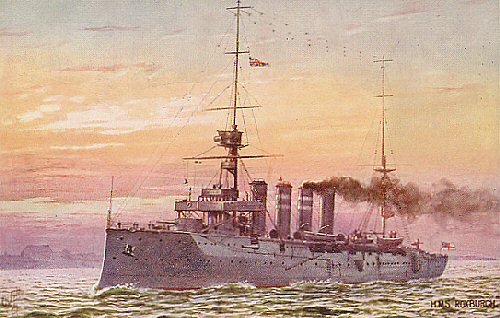
Scrapped 1922
HMS Roxburgh
Displacement: 10,700 tons. Speed: 22.25 knots. Complement: 655. Length: 450 ft. Beam: 68.5 ft. Draught: 25.5 ft. Armament: four 7.5 in guns, six 6 in guns, two 2 pounder guns, twenty-two 3 pounder guns and two maxims plus two 18-inch submerged torpedo tubes. Coal bunkers 800 tons normal, 1,750 tons maximum. Two screws.
The HMS Roxburgh, was a Devonshire Class cruisers of the Royal Navy. The Devonshire class was an attempt at an improvement over the Monmouth class with only a modest increase in size, with a heavier main armament and thicker but narrower belt armor.
HMS Roxburgh was built by London & Glasgow Engine & Iron Shipbuilding Company at Yard No 316. She was laid down June 1902 and launched on 19 January 1904 at an average cost of £850,000 (1901 British Pounds). Until the end of 1908, HMS Roxburgh served with the 1st Cruiser Squadron in the Channel Fleet. After a refit at Devonport she joined the 3rd Division of the Home Fleet in August 1909. She was then moved to the 5th Cruiser Squadron in June 1912. In December 1912 she was ordered to protect the stranded SS Ludgate off Morocco. HMS Roxburgh then joined the 3rd Cruiser Squadron in February 1913 before joining the Grand Fleet in August the next year. On 6th August that year she captured a German merchant ship along with HMS Argyll. After a refit in January 1915, she was hit by torpedoes from German u-boat U39 and sustained damage to her bow on 20th June 1915. Repaired in April 1916 she was sent to Norwegian waters and later on in September of that year she served on the North America and West Indies Station until the Armistice. On 24 May 1917 she escorted her first American convoy from Hampton Roads, Virginia. Painted in dazzle camouflage she rammed and sank German u-boat U89 while escorting a convoy off the coast of Northern Ireland on 12th February 1918. For this achievement she wore a merit mark in the form of a star painted on her fore-funnel.
On July 30, 1918 in a pouring rain, the US 71st Artillery Regiment, together with its complete equipment, was loaded on two British ships, the HMS Margha and the HMS Anselm at Pier 3, East Boston, Mass., Colonel Long with nine-hundred and ninety-two troops on the Margha and Major R. C. Harrison with ten hundred and fourteen troops on the Anselm. HMS Anselm and the HMS Margha, formed part of a small convoy, which sailed from Boston Harbor out past Fort Strong on the morning of July 31, 1918. The convoy was just off Halifax Harbor and Friday morning early passed in by the forts and the town and anchored in the inner harbor. Here they lay until Sunday August 4, when they sailed as part of a field of seventeen transports, at 11:30 am under convoy of HMS Roxburgh. As the convoy made its journey across the Atlantic they had an exceedingly pleasant trip, with but few noteworthy incidents. Early in the morning of August 13 the convoy picked up its destroyer escort consisting of the USS Terry DD-25 and the USS Jenkins DD-42. The men greeted the American ships flying the American flag and manned by US bluejackets with prolonged cheers. On Thursday August 15, the convoy sailed into Liverpool, with flags flying and the band playing on the deck for the first time since leaving Halifax.
In 1919 she went into reserve but then became a wireless trials ship before being sold in 1921 and finally being scrapped in Germany in 1922.